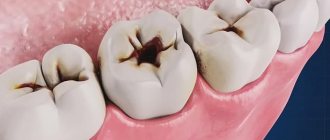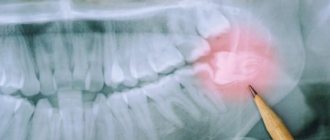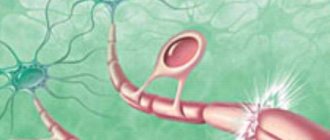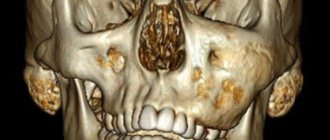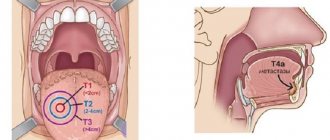No one doubts that every tooth in the mouth is important. The only exception is the “eight”. Their absence does not cause any functional disorders, does not affect the aesthetics of a smile or the ability to chew food. All other teeth are necessary so that the dentofacial apparatus can work as a single coherent mechanism.
With the help of incisors we bite off food, canines and premolars are used to grab food, molars are used to crush and grind food. The loss of any of these teeth inevitably leads initially to discomfort, various functional inconveniences, and later to deformation of the dentition.
Increased load on other teeth
In the absence of any teeth, their function is taken over by neighboring teeth, and accordingly, the load on tooth enamel, crowns and roots increases significantly. This leads to the fact that teeth begin to deteriorate many times faster. For example, when removing molars, the incisors have to take on a task not provided for by nature - grinding food. As a result, longitudinal and transverse cracks appear on the enamel, the edges of the teeth wear off and turn yellow.
Increased load over time turns out to be fatal for the roots, as it provokes their increased mobility. If you do not reduce the constant pressure, bone tissue will also begin to suffer from overload.
What complications can there be?
The complete absence of teeth inevitably causes psychological problems, functional discomfort and quite dangerous consequences for the entire body:
- problems associated with eating: the inability to bite and chew food normally leads to serious diseases of the digestive tract,
- gingival subsidence and bone tissue atrophy, which causes difficulties in prosthetics,
- deformation of the shape of the face, the appearance of wrinkles, reduction of the lower third of the face, retraction of the lips into the oral cavity. If all teeth are missing, a person looks much older than his age.
Bone loss
After a tooth is removed, the bone tissue begins to atrophy. Bone volume decreases by 25% per year, and the process is not as harmless as it might seem at first glance. Bone atrophy can cause adjacent teeth to become loose and even fall out.
Bone loss also creates problems with subsequent prosthetics. If a tooth is missing for too long, doctors have to perform a bone grafting procedure before installing an implant. This significantly increases the overall treatment time and cost.
Consequences of adentia or tooth loss
How are complete dentition and facial appearance related?
The loss of even one tooth already affects the patient’s appearance, let alone when teeth are completely missing. A person ages sharply, and the effect of the so-called “senile face” appears, when the distance from the tip of the nose to the top of the chin decreases greatly. This occurs due to a decrease in the height of the lower third of the face. Since there are no teeth, the support of the lower jaw by the teeth is lost, and the jaw moves backward in the joint area, and forward and upward in the chin area.
This displacement of the jaw leads to a decrease in the tone of the facial muscles, as a result of which the cheeks and chin sag, the corners of the lips go down, even the lips become smaller, as if falling inward. The face becomes more mature.
Dental restoration has a rejuvenating effect, as it allows you to return the lower jaw to its normal position, which provides the necessary support to the soft tissues and restores the smile. After treatment, patients regain confidence and quality of life improves.
How to improve your facial contour without going to a cosmetologist
The “senile face” effect can also occur with partial loss of teeth, especially the chewing group. Sometimes a woman goes to a cosmetologist to tighten her facial contour, and he refers her to a dentist to restore missing teeth. Good, responsible cosmetologists understand that any rejuvenation procedures will not give the expected effect if there are no teeth in place.
How to protect teeth from falling out?
You need to pay more attention to your lifestyle and oral hygiene. The diet must be balanced; the diet must contain fresh fruits and solid foods that contribute to the natural cleansing of tooth enamel. After each meal, it is necessary to clean the oral cavity of food residues, and in the morning and evening, be sure to brush your teeth with a brush and toothpaste.
If no alarming symptoms have preceded it, and teeth begin to fall out, it is immediately recommended to undergo a full examination of the body. Perhaps he is trying to draw your attention to health problems with the help of teeth.
Expert opinion
Vladimir Aleksandrovich Voznyuk
maxillofacial surgeon, implantologist
Experience: more than 33 years
Without proper treatment, almost any dental disease can lead to root inflammation and tooth loss. Therefore, it is necessary to contact a dentist at the slightest sign of pathology in the teeth or gums. Preventive examinations by a dentist are also mandatory, during which a specialist will identify emerging problems and will be able to eliminate them efficiently and as gently as possible.
Methods for restoring missing teeth
The modern level of development of dentistry in almost all cases of violation of the integrity of the dentition makes it possible to solve the problem taking into account all the wishes of the patient. Types of prosthetics:
- Removable dentures. They are necessary if most of the teeth are lost or all of them are missing.
- Fixed. Their use is possible if 1-2 teeth are missing or their main part is destroyed.
- Implantation. This method of prosthetics involves implanting an implant into the bone tissue, onto which a crown is subsequently placed. Implantation is considered the best method of prosthetics, as it returns the desired functionality to the dentition.
The type of prosthetics is selected together with the doctor, taking into account all indications and contraindications.
Missing part of teeth
If several teeth are lost, they can be replaced with dentures made of plastic or nylon, clasps and bridges. Dental prosthetics using implants installed in the jaw is considered extremely reliable. The latter method also provides the most aesthetic results. When implanting into the body of a bone, the validity period of the inserted implants is maximum; the adjacent teeth do not have to be ground down, which is necessary when using prosthetics with bridges. A dental prosthesis placed on an implant implanted into the bone is quite functional, and from an aesthetic point of view, it completely replaces the lost tooth.
Why is it dangerous to lose teeth?
So why is it dangerous to lose teeth? Below is a list of the main problems that result from partial or complete adentia.
Bone loss: the most important thing to be afraid of. We need our teeth not only for chewing food and making speech sounds. The fact is that the roots of teeth act on the jaw bone in the same way as tree roots act on gully soil. Just as trees prevent the earth from eroding and crumbling, our teeth put pressure on the jaw bone, preventing it from shrinking and thinning. The longer a tooth is missing, the more bone tissue decreases.
Displacement and curvature of teeth: as soon as at least one of the teeth disappears from the dentition, its neighbors strive to take its place, this is fraught with the appearance of too large gaps between the teeth, in which food debris and bacteria will accumulate, causing caries. Also, uncontrolled movement of teeth is accompanied by their tilting, curvature and loosening.
Bite disorders: a direct consequence, including the previous point. When teeth are displaced, as well as when there is a “hole” in the dentition from a lost tooth, the correct occlusion - the closure of the jaws - is disrupted. This contributes to changes in facial features, impaired diction, and microtraumas during chewing, for example, biting the cheeks and tongue.
Aesthetic changes in appearance: the more teeth are missing, the more noticeable these changes are. The aesthetic aspects of tooth loss include not only “holes” in the dentition, but also more insidious signs that make us look older: drooping corners of the lips, recessed cheeks, “pushing” forward or, conversely, backwards of the chin, deep expression wrinkles around mouth, impaired lip closure and many others.
Impaired diction: our teeth are an important part of the articulatory apparatus; they are most involved when pronouncing consonants. In the absence of teeth in the anterior region, patients begin to “swallow” sounds, lisp, “whistle,” and speech becomes difficult and unintelligible.
Disorders of the gastrointestinal tract: no matter how trivial it may seem, the absence of even one tooth reduces the thoroughness of chewing food. And this affects the health of our stomach and intestines. And since the human body is a complex system in which everything is interconnected, this threatens many other serious problems and diseases.
Psychological discomfort: All of the above, especially poor diction and aesthetic changes in facial features, make us feel awkward, uncomfortable, unpleasant and reduce self-esteem, and this can eventually result in severe stress, accumulated fatigue syndrome and even depression.
Today, there are various technologies for restoring missing or lost teeth that restore function and aesthetics. All that remains is to choose a suitable implantology clinic.
Teeth become crooked
If one, or even more so, several teeth are missing, occlusion, the correct closure of the teeth of the upper and lower jaw, is disrupted. This is inevitable even if only one tooth is lost. The opposing tooth becomes unsupported and becomes loose. Teeth adjacent to the lost one converge in an effort to fill the empty space. The entire row of teeth gradually begins to move, the bite is disturbed, after which the impact on the jaw joint appears, causing headaches and neck and back pain.
If the teeth are not replaced with dentures, the gaps between them begin to increase, food will get stuck in these crevices, causing caries and other diseases.
The link between dental and heart health
Dental disease and inflammation in the mouth increase the risk of bacterial infection in the bloodstream, and this, in turn, has a negative impact on the heart valves.
Atrial fibrillation, or atrial fibrillation, is considered the most common form of cardiac arrhythmia in the world, and the condition typically involves an abnormal heart rhythm (most commonly tachycardia, a rapid heartbeat). Possible consequences of atrial fibrillation include thromboembolic disease and heart failure. Scientific research has shown that various inflammatory processes in the body, including inflammation that occurs in the oral cavity, play an important role in how atrial fibrillation begins and progresses in patients.




